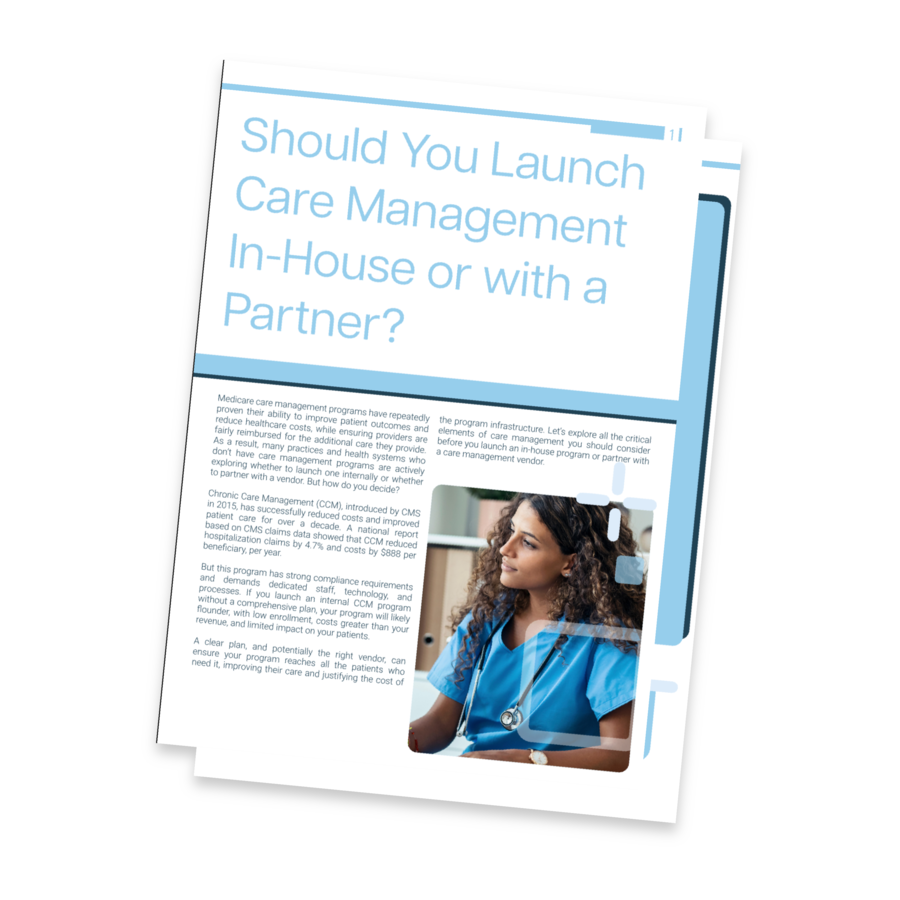
Talk with a ChartSpan Representative Today!
Our team is ready to help you improve patient care and outcomes.
Blog
How to Start a CCM Program: A Comprehensive Guide
Launched by the Centers for Medicare and Medicaid Services (CMS) in 2015, CCM was designed to reward providers for extending value-based care for patients with multiple chronic conditions beyond traditional clinical settings.
By implementing CCM, practices access recurring revenue streams and enhance their overall quality of care delivery. Eligible patients receive a holistic, person-centered approach to chronic illness management. As a result, they often experience lower hospital admission rates and healthcare costs, improved clinical outcomes, and assistance with socioeconomic barriers to care.
However, implementing CCM is a daunting task for most practices. Many healthcare practices are already burdened with demanding workloads, insufficient resources, and overworked staff. The prospect of creating an in-house CCM initiative, educating and enrolling patients in the program, maintaining monthly patient contact, and ensuring CMS compliance is overwhelming. These additional demands, along with high start-up costs, are common reasons why CCM remains surprisingly underutilized despite its documented clinical benefits.
Through this guide, we will offer our industry insights into every aspect of creating a thriving CCM program, from patient engagement to clinical notifications to managing ongoing enrollment and churn. We will also explore how partnering with a full-service CCM company, like ChartSpan, relieves the heavy workload associated with CCM and helps your practice attain the program’s numerous benefits without requiring additional investments of your valuable time and resources.
10 Steps to Start a Chronic Care Management Program
CCM programs are extraordinary opportunities to add additional revenue channels to your practice while elevating the quality of care you provide to your chronically ill patients*. However, without proper preparation and deliberate planning, your CCM endeavor will struggle. Here are ten crucial steps to take when establishing a CCM program:
1. Evaluate the requirements for a CCM program
The results of a meticulously implemented CCM program are transformative, but the program itself is notoriously complex to manage. Before undertaking an in-house CCM program, you need to scope out the numerous requirements and be prepared to adjust internal strategies as CMS continues to update and expand the program. A thorough understanding of the program’s demands from the outset minimizes the risk of your practice becoming blindsided by unexpected responsibilities and documentation requirements, including time logs, care plan changes, communication with other care providers, and any patient or caregiver communication.
If you are managing the CCM program internally, your practice will be responsible for operating a 24/7/365 care line. Your practice staff will also be responsible for acting as CCM care managers. They will need to perform a high volume of monthly calls to enrolled patients, in addition to completing subsequent care coordination tasks like revising care plans and care goals, assisting with medication refills and scheduling transportation arrangements. Your practice will also need to maintain compliance and billing records. You may have to hire and train additional staff to tackle this significant influx of work.
Accessing CMS reimbursements requires rigorous documentation of patient health information and the care management services provided to participants. Your practice must also understand CMS’s billing requirements, verify patient eligibility, and ensure that you have the necessary staff to perform the required care coordination and maintain monthly communication. These are just a few considerations a practice must make when starting a comprehensive CCM program.
Learn more: Chronic Care Management: Benefits, Requirements, & Reimbursements for Providers
2. Explore the resources, infrastructures, and workflows involved in CCM operations
Before launching your own CCM program, your practice must evaluate the necessary resources, staffing requirements, workflow optimizations, and infrastructural demands.
Your practice must be equipped to handle the infrastructural demands of a CCM program. For example, depending on the scale of your CCM program, you may need to invest in technological upgrades, like an expanded telephonic system capable of handling outbound patient check-ins and inbound care line calls. You will also need to devise a strategy to automate and standardize workflows so you can ensure compliance and consistency in all your CCM endeavors.
If you’re collaborating with a CCM company, like ChartSpan, you’re less likely to need new staff. However, your staff will still need to review patient eligibility lists, review the care plans and goals, and manage CCM clinical notifications from your CCM partner’s nurses, who will be working under the general supervision of your providers.
It’s also critical to identify a champion who will help lead your implementation efforts. Though you may have a CCM partner to help with implementation, you will still need a designated internal leader to attend meetings, respond to emails, set timelines, and sign off on scope.
CCM is most effective when it can operate seamlessly at scale. This can be difficult for practices to achieve, as they are limited by their available staff, time, and resources. A CCM partner like ChartSpan can effortlessly scale your program, as we already have staff and infrastructure in place. Our team is capable of meeting CMS’s requirements and eager to devote their skills to maximizing enrollment and elevating patients’ experience.
3. Review patient eligibility
Before implementing a CCM program, you must first review whether or not you have enough eligible patients to justify launching the initiative. CCM is available to all Medicare Part B recipients who have two or more qualifying chronic conditions. These chronic conditions must be expected to last at least twelve months or until the end of the patient’s life.
If you don’t have a CCM partner, you must analyze your EHR and create a list of eligible patients. Patients with conditions like COPD, diabetes, hypertension, or behavioral health conditions are often eligible for CCM.
Approximately 82% of Medicare beneficiaries qualify for CCM services, which makes it ideal for any practice with a high volume of patients over the age of 65. CCM can be especially beneficial to specialists like cardiologists, nephrologists, and urologists, who often serve a significant number of older patients.
Determining patient eligibility for CCM is an ongoing process. Patients continually become eligible through joining Medicare or being diagnosed with a second chronic condition. Patients also churn out of the program, either because they’ve entered a full-time assisted care facility or passed away.
Practices that run their own CCM program are responsible for continuously pulling and assessing patient eligibility lists. If you partner with a CCM company, their team can pull updated lists regularly and provide them to your providers for quick review and approval, per CMS’s guidelines.
4. Educate and enroll patients
Patient enrollment is crucial to the success and profitability of your CCM program. Patients will only enroll in the program if they clearly understand Chronic Care Management and the enormous potential value it can bring to their care journey. All providers and clinical staff members and any CCM partners should be equipped to educate patients about CCM.
The enrollment process is broken up into three stages: the education campaign before enrollment, the enrollment process, and welcoming patients after their enrollment.
Before enrollment:
Before enrolling patients in CCM, your practice should embark on an education campaign through options like in-person communication, phone calls, direct mail, or printed materials in your office and waiting room. Your practice will play a key role in introducing CCM to your patients, instilling trust in the program, and generating enthusiasm.
You can use brochures, posters, and slideshows to educate patients when they arrive at your office for scheduled appointments. Text messages, voicemails, and physical mail can also be sent out to all eligible patients to familiarize them with the program before asking for their consent to enroll.
If you collaborate with the right CCM partner, they should help you craft effective, educational messaging, using industry-proven informational language. CCM partners can also train your internal staff on the benefits of CCM so you feel confident explaining it to your patients. They might also provide emails, recorded voicemails, phone calls, mailers, and printed marketing materials for your use.
The enrollment process:
After educating patients on CCM, it is time to ask for their consent and enroll them in the program. Patient enrollment calls frequently involve:
- Verifying a patient’s identity
- Expounding on the many benefits of CCM to patients
- Discussing the unique features of CCM, like monthly check-ins, care plans, care coordination, and access to a 24/7/365 care line
- Explaining that Medicare pays for CCM, but deductibles and copays apply
- Explaining that a patient may unenroll at any time and may only be enrolled under one provider
- Asking the patient if they would like to enroll in CCM
- Recording and archiving the call for at least 10 years
Patients must explicitly state they want to sign up for CCM before they can enroll. Some clinical staff are comfortable calling patients to enroll them, but many practices prefer to use trained enrollment specialists from a CCM company to perform these calls. Enrollment specialists are experienced in the intricacies of CCM and familiar with the many questions or reservations patients may have about the program. Specialists also have the time and focus to devote to CCM enrollment, while clinical staff have to juggle many responsibilities. ChartSpan’s skilled team of specialists averages a 45% enrollment rate.
An effective CCM partner will also employ patients’ insurance and demographic information to estimate patient co-pays and accurately share financial obligations with the patient.
After enrollment:
After enrolling in a CCM program, patients may still have questions or concerns about the program. A good CCM program will provide materials to answer those questions. ChartSpan offers patients a welcome packet that includes detailed information about CCM services, frequently asked questions, and contact information for care managers and the care line. Enrolled patients also receive a personalized call from their care manager.
Ensuring that patients feel welcomed and well-informed immediately after joining the program helps establish trust in the program and lays a valuable foundation for a successful partnership.
5. Develop continuous patient engagement plans
If you don’t have a CCM partner, your practice will need to develop strategies to maintain high levels of patient engagement. Patients must continue to be activated, educated, and supported after enrollment. This facilitates improved clinical outcomes and will contribute to your CCM program's success by keeping enrollment levels high.
Care managers can accomplish this by sharing dietary and exercise plans for patients, checking in on wellness plan progress and adherence, and providing resources targeting Social Determinants of Health (SDOHs), like transportation assistance, financial aid resources, and suggestions for community activities.
Your CCM program should also include re-engagement strategies for patients who stop answering their CCM care manager’s monthly phone calls. This can include voicemails, texts, and emails. If you are partnering with a CCM company like ChartSpan, they will possess a wealth of experience in maintaining patient engagement and re-engaging disaffected patients.
6. Plan out the patient's care journey
Supporting each patient throughout their wellness journey is the core of every well-run CCM program. Care managers should use wellness plans, personalized care goals, and preventive care to promote positive clinical outcomes and optimal quality of life for enrolled patients.
CCM care managers should be trained to identify gaps in care and assist patients in scheduling appointments, screenings, and vaccinations required to close them. They should also be equipped to detect signs of loneliness and behavioral health struggles and administer depression screenings like PHQ-2s. Additionally, they must be prepared to help patients with medication refills, transportation access, and food resources if they identify SDOH barriers hindering a patient’s care journey.
ChartSpan uses SMART (Specific, Measurable, Achievable, Relevant, and Time-Based) goal guidelines to help patients create individualized care goals for their wellness journey. We’ve also crafted a program called ChartMarkers to inventory patients’ conditions, identify areas where they need additional care, and intervene where necessary. Some of the assessments we provide include:
- Clinical assessments
- Medication adherence assessments
- Quality assessments to identify care gaps
- Social Determinants of Health assessments
7. Ensure accurate billing through proper coding and program compliance
By providing value-based care to your chronically ill patients, your practice can access additional recurring revenue channels. If you want to maximize these financial reimbursements, your clinical staff must thoroughly understand the billing rules, service requirements, and CPT codes associated with CCM.
CCM services are billed based on the non-face-to-face care coordination services provided by either your clinical staff or your CCM partner’s team. These services are billed to CMS monthly, and the CPT codes billed will vary based on the complexity of care provided and the aggregated time spent providing care. Your practice needs a thorough record of the CCM care coordination services provided to your patients to remain compliant with the program.
Therefore, ensuring proper billing is another complex, time-consuming element of CCM that many practices find daunting to implement without help. ChartSpan’s RapidBill technology allows your practice to easily review and bill CCM services each month. We assemble the necessary documentation and provide the appropriate CPT codes to your practice. Your staff will simply need to review the codes and submit the bill to CMS. With RapidBill, you can smoothly integrate recurring revenue streams into your practice.
Learn more: Chronic Care Management CPT Codes & Billing Guide
8. Establish clinical alignment for your CCM program
Streamlined clinical alignment ensures that your CCM program operates smoothly and reliably. If you partner with a CCM vendor, you must establish how your practice will handle tasks including:
- Pulling C-CDAs to gather patient eligibility data
- Initiating communication about specific patient needs through notifications
- Triaging calls and sending notifications about emergencies or urgent needs
A strong CCM partnership will facilitate a consistent cadence for pulling C-CDAs and reviewing patient lists.
You and your CCM partner should also plan how often your practice will check clinical notifications. Notifications should go two ways–in addition to seeing notifications from your CCM partner, you should be able to send them notifications when you’d like them to address a specific condition or concern with one of your patients.
Establishing a plan for triage calls is another essential element of CCM. Your partner should provide a fully staffed 24/7 care line with a clear triage protocol. In an emergency, the CCM nurses will contact 911 immediately. After the patient has received care, your CCM partner will notify your practice about what happened. Set up a clear protocol for how you prefer to receive urgent notifications so your providers can quickly follow up with the patient.
9. Set measurable success goals
Practices must set practical and measurable goals to achieve CCM success. This should encompass patient enrollment, patient retention and satisfaction, and care plan goals. You may also set goals around improving your practice’s quality scores, such as your scores under CMS’s Merit Incentive Payment System (MIPS) or under the Overall Hospital Star Rating.
Your team should define success before beginning CCM implementation, frequently assess your progress, and evaluate any necessary adjustments.
If you have a CCM partner, they can help you develop realistic, industry-informed goals. For example, ChartSpan targets a 45% enrollment rate. To reach this objective, we deploy a slow enrollment ramp-up over the first six months of the partnership and continually test new enrollment and education methods
The ChartSpan clinical team also sets goals for every enrolled patient to have care goals within the first two months of the program and for every patient to receive clinical and medication adherence assessments when they answer the phone. We consult with practices throughout the partnership to determine what other goals they would like to work toward.
Learn more: Quality Improvement: Processes & Best Practices in Healthcare
10. Partner with ChartSpan to maximize your CCM program’s success
CCM is complex and time-intensive. Many practices find that implementing the program causes major disruptions to their workflow, demands additional staff and infrastructure investments, and generates many new administrative tasks. However, when you partner with a CCM company, many of these burdens are removed, allowing you to deliver exceptional care to your chronically ill patients and receive ongoing reimbursements.
ChartSpan supplies your practice with everything you need to keep your CCM program running smoothly. We have specialists who will check on patient eligibility, handle outreach, and effectively enroll your patients in the program. Our compassionate care managers will act as an extension of your practice, providing every enrolled patient with a monthly call and the assistance and care coordination needed to optimize their care journey. Our 24/7/365 care line is staffed with care coordinators and nurses who can field whatever questions your patients have and escalate emergencies when appropriate. Through RapidBill, we’ve radically simplified the billing process for your practice.
We also provide complimentary quality improvement specialists who will help you boost your quality scores, and our team handles onboarding your staff and providing continuous education about the program.
ChartSpan’s 6 steps to set you up for CCM success:
- Onboard: We thoroughly train your entire staff on the intricacies of CCM.
- Identify & Enroll: We identify eligible patients, provide you with the list, and enroll them in the CCM program with your approval.
- Engage: We reach out to your patients and engage them actively in their care management journey.
- Intervene: We help your patients achieve positive clinical outcomes through care coordination and preventive care facilitation.
- Measure: We track quality measures and improvements, track performance metrics, and assist with program compliance.
- Bill: Our proprietary RapidBill technology removes the complexities of billing, allowing you to simply review and submit your bill to CMS each month.
Explore how ChartSpan can help you start a CCM program
CCM is notoriously difficult to implement. But it doesn’t have to be. When your practice partners with a full-service provider of CCM services like ChartSpan, you can enjoy the transformative benefits of CCM without the stress of overworking your current staff. Contact us to learn more about the impact ChartSpan’s CCM program could have on your practice’s care delivery.
You may also like:
Subscribe for More Insights
Get valuable resources delivered straight to your inbox.
"*" indicates required fields






